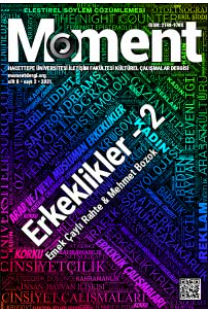ARŞİV İMGESİNİN FİLM ORTAMINDA İNŞASI ÜZERİNE BİR İNCELEME
AN EXAMINATION ON THE CONSTRUCTION OF IMAGE OF THE ARCHIVE IN FILM MEDIUM
archive, image, cyborg, film, mental image, representation,
___
- Arlene Schmuland, 1999. The archival image in fiction: an analysis and annotated. The American Archivist, (62) 1, 24-73.
- Arnheim, R. (2015). Görsel düşünme. (R. Öğdül, Çev.) İstanbul: Metis Yayınları.
- Berger, J. (2015). Bir fotoğrafı anlamak. (B. Eyüboğlu, Çev.) İstanbul: Metis Yayınları.
- Biro, M., (2009). The dada cyborg. Minneapolis: University of Minnesota Press.
- Bonitzer, P. (2017). Kör alan ve dekadrajlar. İstanbul: Metis Yayınları.
- Buckland, M. K. (1997). What is a Document? Journal of the American Society for Information Science, 48 (9), 804-809.
- Clark, A. (2003). Natural-born cyborgs: minds, technologies, and the future of human intelligence. New York: Oxford University Press.
- Derrida, J. (1995). Archive fever. Diacritics, 25 (2), 9-63.
- Featherstone, M. (2006). Archive. Theory, Culture & Society, 23(2–3), 591–596. Erişim https://doi.org/10.1177/0263276406023002106
- Foucault, M. (2006). Utopian body. C. A. Jones (Ed.), Sensorium: embodied experience, technology and contemporary art (s. 229-234) içinde. The MIT Press.
- Foucault, M. (2014). Bilginin arkeolojisi, İstanbul: Ayrıntı Yayınları.
- Freud, S. (1930). Uygarlığa dair hoşnutsuzluğumuz. İstanbul: Epsilon Yayıncılık.
- Haraway, D. (2010). Siborg manifestosu: yirminci yüzyılın sonlarında bilim, teknoloji ve sosyalist feminizm, Güçsal Pusar (Ed.) Başka yer. İstanbul: Metis Yayınları.
- Herd, P., James, T., Palfrey, C. (Yapımcılar) ve Rothery, G. (Yönetmen). (2020). Archive [Film]. UK, Hungary, USA: Independent, Hero Squared, Head Gear Films.
- Gillett, L. (Yapımcı) ve Armstrong, F. (Yönetmen).(2009). The Age of Stupid. [Film]. UK. Passion Pictures § Spanner Films.
- Kittler, F. (1992). Discourse networks 1800/1900. Stanford, Calif.: Stanford University Press.
- Laurentiis, D. D. (Yapımcı) ve Bergman, I. (Yönetmen). (1977). The Serpent’s Egg [Film]. West Germany § United States. Dino de Laurentiis Company, Railto Film, Bavaria Film.
- Manoff, M. (2004). Theories of the archive from across the disciplines. Libraries and the Academy, (4) 1, 9–25.
- Mitchell, W. J. T. (1984). What is an image? New Literary History, 15(3), 503–537. Erişim https://doi.org/10.2307/468718
- Oliver, A., ve Daniel, A. (2015). The identity complex: the portrayal of archivists in film. Archival Issues, 37(1), 48–70. Erişim http://www.jstor.org/stable/24590116
- Osborne, M. (1999). The ordinariness of the archive. History of the Human Sciences, (12) 2, 51-64.
- Parker, J. (Yapımcı) ve Parker, J. (Yönetmen). (2001). Bartleby. [Film]. United States. Parker Film Company.
- Schmuland, A. (1999). The Archival image in fiction: an analysis and annotated bibliography. The American Archivist, 62(1), 24–73. Erişim http://www.jstor.org/stable/40294103
- Suchman, L. (2019). Demystifying the intelligent machine. T. Heffernan (Ed.), Cyborg Futures (s.40-61). Cham: Palgrave Macmillan US.
- Tanju, B. (2016). Pazar Sekmeleri: Arşiv Humması. Manifold. Erişim https://manifold.press/pazar-sekmeleri-arsiv-hummasi
- Wilson, J. (1995). Enter the cyberpunk librarian: future directions in cyberspace. Library Review. 44 (8), 63-72. Erişim http://www.emeraldinsight.com
- Zeng, D. and Wu, Z. (2014). From artificial intelligence to cyborg intelligence. IEEE Intelligent Systems, (29), 5: 2-4. doi:10.1109/MIS.2014.83
- ISSN: 2148-970X
- Yayın Aralığı: Yılda 2 Sayı
- Başlangıç: 2014
- Yayıncı: Hacettepe Üniversitesi İletişim Fakültesi
Oktay ÜÇER, Gökhan TEMELTAŞ, Talha MÜEZZİNOĞLU, Zeki ARI, Funda KOSOVA
İNSANSIZ HAVA ARACI GÖRÜNTÜLERİ VE BARIŞ GAZETECİLİĞİ: İKİNCİ KARABAĞ SAVAŞI ÖRNEĞİ
MEDYATİK EĞLENCE, DİJİTAL GÖRÜNTÜ, YENİ BELGESEL: 360 DERECE VİDEO ÜZERİNE BİR İNCELEME
SANATIN YENİ TEKNOLOJİSİ: NFT ÖZGÜN VE ÖZGÜR MÜ?
WALTER BENJAMIN NFT'LERE TANIKLIK ETSEYDİ: KRİPTO SANATA ONUN GÖZÜNDEN BAKMAK
FLÖRT UYGULAMALARINDAKİ İMAJLAR DÜNYASI: “KLİŞELERİN DİKTATÖRLÜĞÜ”NE KARŞI DOĞALLIK
ARŞİV İMGESİNİN FİLM ORTAMINDA İNŞASI ÜZERİNE BİR İNCELEME
DİJİTALİN DÖNÜŞTÜRDÜKLERİ: ANALOGDAN DİJİTAL FOTOĞRAFA SÜREKLİLİK VE KOPUŞ
YÜZÜNDE FARKLI OLMAK VE FARKIN GÖRSEL TEMSİLİ ÜZERİNE BİR TARTIŞMA
FOTOĞRAFLAR ARACILIĞIYLA (GÖÇMEN) KADINLARIN YAŞAMLARINI VE HİKAYELERİNİ ARAŞTIRMAK
